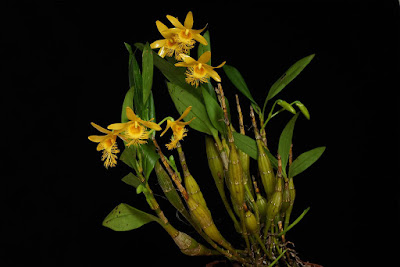Dendrobium brymerianum is native to Assam Province in north-east India, Myanmar, northern Thailand, Xieng Khouang area in northern Laos and southwest China. In Thailand, they grow near Chiang Mai at an altitude of 1520-1590 m, and at an altitude of 1450 m northwest of Pai.
Dendrobium brymerianum, also called as The Brymer's Dendrobium (named after the English Orchid Enthusiast Brymer), Callista brymerana, is a species of the genus Dendrobium. This species was described by Heinrich Gustav Reichenbach in 1875.
IDENTIFY DENDROBIUM BRYMERIANUM
Dendrobium brymerianum is native to Assam Province in north-east India, Myanmar, northern Thailand, Xieng Khouang area in northern Laos and southwest China. In Thailand, they grow near Chiang Mai at an altitude of 1520-1590 m, and at an altitude of 1450 m northwest of Pai.
It is a small to medium sized, cool growing epiphyte, which reaching 20-50 cm in height, that has an erect, yellowish, 20-50 cm long pseudobulb with 2 swollen, central internodes carrying 6 leaves per growth with the apical, oblong-lanceolate, thin-textured, shiny, rich green, 10-15 cm long, and leathery leaves persisting for several growing seasons and then become deciduous.
The Brymer's Dendrobium blooms in the spring and again in the fall from the lateral or subterminal, 4" (10 cm) long, racemose inflorescence arise from the nodes near the apex of the mature pseudobulb with 1 to 5, extremely fragrant, spreading, glossy, short lived flowers. The flowers have a diameter of 5.0-7.5 cm. The bright, golden-yellow flakes of both whorls are spread out, equal in size and shiny. The lip is sometimes golden-yellow, sometimes dark orange. It may have a yellow-green middle plot. The edges of the lip is fringed, with divergent, branching and re-connecting nerves, creating an extremely fringe-like tassel on the lip. The side lobes of the lip also have tassels.
DENDROBIUM BRYMERIANUM CARE AND CULTURE
Cultural information should only be used as a guide, and should be to be adapted to suit you. Your physical location; where you grow your plants, how much time you have to devote to their care, and many other factors, will need to be taken into account. Only then can you decide on the cultural methods that best suit you and your plants.
Light:
Dendrobium brymerianum needs a light level of 25000-35000 lux.
Temperature:
It is a moderately thermophilic plant and requiring a cold resting period. In summer the average day temperature is 23-25 ° C, the night 16-17 ° C, which gives a daily difference of 7-9 ° C. In spring, the average day temperature is then 27-28 ° C, night 10-16 ° C, with an average amplitude in the range of 11-18 ° C. In winter the average day temperature is 22-28 ° C, at night 6-10 ° C, which gives a daily difference of 15-18 ° C.
Humidity:
The Brymer's Dendrobium needs a humidity level of 75-85% from late spring to autumn, and falling to almost 60% at the end of winter and early spring.
Substrate, growing media and repotting:
Dendrobium brymerianum grow well attached to pieces of tree ferns or cork, as long as we can provide high humidity, which requires daily watering during the summer. If the plants are grown in pots, any loose, fast-drying substrate can be used. Repotting is best done in the spring when the growth of new roots begins.
Watering:
In the period of active growth (the period from spring to early autumn), cultivated plants should be watered abundantly, while when new growths reach maturity, the amount of water should be gradually reduced.
Fertilizer:
Dendrobium brymerianum should be fertilized every week 1/4-1/2 of the recommended dose of fertilizer for orchids. A fertilizer with a high nitrogen content is beneficial from spring to mid-summer, and a fertilizer richer in phosphorus should be used in late summer and autumn.
Rest period:
A cool and dry resting period is essential for Dendrobium brymerianum in the crop and should last until the growth of new growths in the spring begins. From the time when new increments reach maturity, it is important to keep plants growing in cool and dry conditions until flowering, but they can also tolerate night temperatures in the range of 13-16 ° C.
The plants tend to be healthier if they are allowed to dry completely between waterings for most of winter, but do not stay dry for longer. For 1-2 months at the end of winter, the conditions are bright, warm and dry with a humidity so low that there is no moisture in the form of morning dew. At that time, the plants should be allowed to dry completely before further watering and to extend periods of drought between them. To prevent excessive drying, plants can sporadically be sprinkled between watering early in the morning. Fertilization should be limited or should be completely abandoned until spring, when stronger watering resumes.















COMMENTS